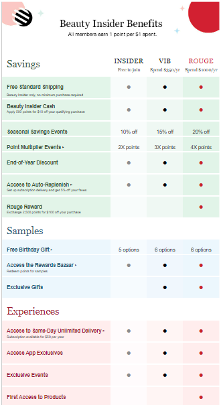Over the years, there have been debates as to whether customer loyalty program designs should feature tiers with associated differential benefits. Some loyalty experts and practitioners have advocated that the introduction of tiers might feel undemocratic and can add complexity to the program design and contribute to a lack of comprehension by members and employees.
As for member sentiment in regard to being treated differentially, the pendulum has definitely shifted. Members of programs are accustomed to receiving incremental program value with greater levels of financial commitment to a brand. In fact, program members expect that from brands that they do business with.

As for the notion that tiers can add program complexity, this should not be dismissed. There are certainly several loyalty programs in the marketplace that have too many tiers, an excess supply of benefits inside of each tier as well as an abundant number of conditions and restrictions associated with tiers. Frequent flier and hotel programs are usually the poster children for these issues, although several airlines have begun to simplify their tiered structures. Frequent flier programs tend to be laser focused on discerning the differences of multiple tiers in their efforts to motivate increased frequency and spend with their brands. While tiers tend to be successful especially with airline and hotel programs, they are often too complex, especially for the masses who are less loyal and therefore cause potential members to disengage.
The loyalty mechanic of tiers is rooted in human neuroscience originating from a human behavioral model founded by two Harvard Business School professors, Paul Lawrence, and Nitin Nohria. The model they established is called the Four Drive Model. The model advocates that as human beings we have two biological drives that are transactional in nature and two other biological drives that are emotionally grounded. For purposes of tiers, we will focus on the two transactional drives, the Drive to Acquire and the Drive to Defend.
The Drive to Acquire
This drive advocates that as human beings we tend to be hunters and gatherers. We are predisposed to collect things that are of value to us. In loyalty terms, this translates to program members collecting points, miles, discounts, free stuff, and other benefits etc.
The Drive to Defend
This drive suggests that as human beings we tend to protect those things that are near and dear to us. Once we hunt and gather these possessions, we will go to great lengths to protect these belongings. In loyalty terms, program members tend to value, covet, and protect the status and benefits that we earn through the commitment we show to a brand. We will go to great lengths (sometimes making irrational decisions) to maintain these possessions.
Tiers are a loyalty mechanic borne out of this Drive to Defend. When configured properly, tiers can have the effect of motivating members’ behaviors to do things they might not otherwise do.
- How many of us have taken a more expensive flight to retain our frequent flier status with an airline?
- How many of us have spent more to move up to a higher loyalty program tier?
- How many of us have spent more with a brand to get exclusive rights to an experience in a top tier of a loyalty program?
The answer is many of us.
While tiers do not motivate everyone to enact a spend or frequency behavior that they would otherwise not engage in, there is sufficient evidence that tiers can influence a reasonably large volume of members to do so.
In a recent survey conducted by Loyal Strategy Consulting on the topic of tiers, loyalty and business professionals where asked: What is the number one reason for a brand to introduce a tiered loyalty program?
Here’s what they said:
- 42% of respondents claimed that the key reason was to drive member spend and frequency
- 33% felt that it could permit a brand to recognize and reward members differentially for their loyalty
- 25% said it allows the brand to optimize their dividend investments against members
These are all very valid reasons for brands to consider introducing a tiered loyalty program. Loyal Strategy Consulting has several guiding principles which we recommend to clients to ensure that the introduction of a tiered loyalty program is properly engineered for all stakeholders: members, employees, program partners and the brand proper.
1. Number of Tiers – It is important not to over dissect your member file and design too many tiers, as it can make it complicated for members to understand and employees to explain, let alone to participate in. A general rule of thumb is to create approximately three (maximum four) tiers. The bottom tier usually consists of infrequent members and the intent is to migrate their frequency and spend to a mid tier. The mid tier tends to be comprised of members who likely split their spend with your brand and competitors. The intent of having a top tier is to get those members in the mid tier to think of your brand first and provide them with sufficient motivation to consolidate their frequency and spend solely with your brand. The top tier is more of a recognition and reward tier that overtly acknowledges these high value members’ financial and emotional commitment to your brand with meaningful and coveted benefits and privileges that are envied by the other tier members.

2. Distance of Tiers – When mapping out the precise qualifications required for a member to participate in the benefits of a tier, it is important to ensure that there is sufficient space (spend and/or frequency) between tier qualification. This will ensure that there is enough motivation for members to change behaviors with the brand. It is also vital to ensure that the distance between tier qualification is realistic and grounded in data to set members up for success. Too much of a stretch to the next tier will only frustrate members and result in disengagement. Striking the right balance is an art and science.
3. Benefits Inside of Tiers – The general hypothesis is that the higher up the tier the more valuable the suite of benefits inside of that tier. It is important to ensure that the entry level tier has adequate benefit to entice members to join the program and stay engaged. Be cautious not to overload this entry level tier with benefits and therefore resulting cost, which might inhibit your ability to provide incremental investment to higher tiers. Benefits housed inside of the mid tier should be sufficiently more advantageous than the entry tier to provide motivation for the entry tier to migrate upward. As for the top tier, this is where a brand should invest to make members feel special but be cautious not to over invest as there is likely less potential for incrementality from this tier. The name of the game is recognition and retention for this top tier.
4. Monetary vs. Non-Monetary Benefits – It is important to not be over reliant on transactional benefits. Usually, the entry level tier will need to have monetary incentives for members to join the program. Again, be cautious not to over invest in this tier as it could become quite expensive, with a lower rate of return. The role of the tier is to whet their appetite for more benefits and privileges as they show more commitment to your brand. As you consider the suite of benefits in the mid tier, incremental monetary value is mandatory and should be coupled with the introduction of non-monetary benefits in the way of access, services, conveniences, and recognition benefits. As for the top tier, while there must be a strong monetary benefit, these members value emotional connectively with the brand and will seek out benefits and privileges that are scarce, coveted and personalized that make them feel special. Think about all of the assets within your business and partner’s ecosystem, whether product or services, that you can bring to bear for this very important cohort of members.

5. Published vs. Unpublished Tiers – It is critical to ensure that all benefits housed inside of a tier are clearly articulated for members in a manner that is easily understood and remembered. Having said that, sometimes brands also offer unpublished rewards in the form of surprise and delights to wow their members. These are customarily found in top or very top tiers. When a member does not expect to receive a benefit/privilege and gets it serendipitously, it can have a much higher perceived value and will undoubtedly have even greater amplification to that member’s circle of influence.
6. Investment by Tier – It is vital to do the math to determine where your loyalty program will have the highest propensity to motivate behaviour change. The bottom tier is all about member acquisition and grooming. The mid tier is focused on spend consolidation and upward migration and the top tier is focused on recognition and retention. When making decisions about investments by tier, it is important to break down your member file by deciles to understand where the opportunities for growth by members exist and where there are potential risks of spend/frequency slowdown and attrition. These realities should guide investment levels by tier.
7. Tier Duration, Qualification and Requalification – Usually, it is customary to have the tier qualification operate as follows: a member may qualify at any point in the year, and the duration continues for the remainder of that said year and the following full year. The same applies for requalification. We have seen brands extend requalification periods under extraordinary conditions, recently during COVID-19 where brands provided extensions.
Do all loyalty programs need tiers to be successful? The answer is no. There are many examples of loyalty programs worldwide that are highly successful without the use of tiers. Having said that, we do know that when tiers are employed properly, they can be highly effective at influencing member behavior and building transactional and emotionally loyalty to a brand.
There are many considerations that need to be accounted for when designing a loyalty program with tiers. As mentioned earlier, it is imperative to construct a tier program which is considerate of all program constituents: members, employees, program partners and the brand proper.
The omission of any of these stakeholders in the design, will result in a flawed structure which will not achieve the desired outcome. For more information about program tiering design, visit: https://loyalstrategyconsulting.com
About the Author:

Richard is a highly accomplished customer engagement thought leader and loyalty practitioner who has designed, renovated, and managed some of the world’s leading customer loyalty programs. He has an impeccable track record of success at enriching transactional and emotional relationships between iconic brands and their customers, across multiple business sectors. Richard has spent the first half of his career in senior loyalty roles with several renowned brands and the remainder of his career in leadership roles with leading loyalty agencies. Currently he is the Founder & Chief Customer Engagement Officer of Loyal Strategy Consulting, a consulting firm focused on enriching customer loyalty for leading brands. Richard can be reached at: rschenker@loyalstrategyconsulting.com




